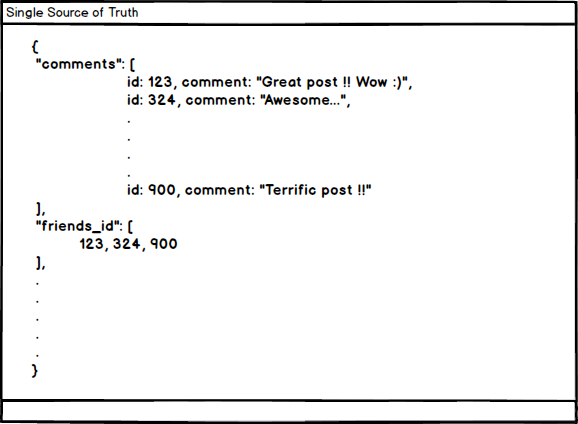
Introduction
Redux can be complicated at first.
But after you understand the basics it can be very easy.
This article will ensure that you understand Redux with the help of some examples.
After reading this article I promise you, you will say this -

This article will make you fall in love ❤️ with Redux.
According to the official site, Redux is a predictable state container for JavaScript Applications.
Now what the hell 😕 that means.
Well I’ll try to explain it in parts.
Table of Contents
- Why we need Redux?
- Immutability
- Pure Functions
- Three Principles of Redux
- Examples
- Dependants of Redux?
- Conclusion
1. Why we need Redux?
Managing State of Application can become cumbersome when the application is a mid-level or enterprise-level application.
That’s why we need a mechanism to manage state efficiently so that it can scale to any application from small scale to large scale.
Enter Redux
Redux makes it easy to store the state of any application efficiently.
It does that by creating 1 giant object & this giant object consists of all the application state.
Now you might be thinking what the hell is state 😕 !?
State can be anything in the application that needs to be remembered by the application.
For example,
Consider a simple COUNTER APPLICATION which consists of the CURRENT COUNT & also has 2 buttons INCREMENT & DECREMENT.

Here, the only thing to be remembered in the application is the CURRENT COUNT value as it is the one changing constantly whenever user clicks INCREMENT or DECREMENT button that’s why for the COUNTER APPLICATION, the state is CURRENT COUNT.
Consider another example application like a BLOG POST, it will consists of a lot of different blogs.

Each of the blog post will have COMMENT section & each of the comments will have HEART to show some love to the post. Here, the state of the application which needs to be remembered is the COMMENT & HEART as these are the ones changing.

COMMENT is in the state because if someone clicks on HEART to show some love the comment then on which comment it was clicked must be remembered so that’s the reason COMMENT is needed or if you prefer you can use a specific ID which is unique for each comment as the state.
I hope these might have cleared what state really is 😃
2. Immutability
Immutability means something that cannot be mutated, i.e, changed or modified after its creation.
Consider an example in JavaScript,
let str = `Hello JavaScript`;
console.log(str.substr(0, 10));
console.log(str);
The result of the above code is -
Hello Java
Hello JavaScript
The substr() method on String does not mutate the original string str. That’s why strings in JavaScript are immutable.
They are not the only immutable value in JavaScript. Numbers are immutable too.
Numbers example -
let x = 10;
x = x + 1;
The result of the above code gives value of x to be 11.
Now you might be saying how is this immutable !? 😕
The first statement var x = 10; assigns value 10 to variable x.
The second statement references the x to the current value of x + 1.
The statement doesn’t change the meaning of value 10.
The memory allocated to x refers to the new value 11.
Arrays are mutable in JavaScript.
Consider an example -
const arr = [1, 2, 3];
arr.push(4);
console.log(arr);
The result of the above code is -
[1, 2, 3, 4]
This makes sense as Arrays are mutable.
Consider same example using Immutable JS -
const arr = Immutable.List.of([1, 2, 3]);
arr.push(4);
console.log(arr);
The result of the above code is -
[1, 2, 3]
This is because of Immutability.
Read Immutable JS docs to learn more about Immutability in JavaScript.
Now why would we use Immutability anywhere !? 🤔
Immutability gives a lot of predictibility.
It means you don’t have to check if some array is modified in the code you know it isn’t changed by any assignment operator because of its immutable nature.
Example -
const arr = new ImmutableArray([1, 2, 3]); // Imaginary class which creates an Immutable Array
const newArr = arr.push(5);
/*
******************************************
******************************************
******************************************
******************************************
******************************************
******************************************
******************************************
******************************************
******************************************
some big chunk of code which edits `newArr`
******************************************
******************************************
******************************************
******************************************
******************************************
******************************************
******************************************
******************************************
******************************************
*/
console.log(arr);
/*
arr is still the same here - [1, 2, 3]
if it wasn't immutable it would've changed to the value of newArr
*/
This helps in reducing errors & makes us more productive.
It also comes with performance benefits, more times than other.
If you consider Immutability in some parts of operations isolated then the performance will be less.
But if you consider overall performance then it will be a huge benefit.
The following articles are great to know about Immutability in JavaScript -
Immutable Javascript using ES6 and beyond
3. Pure Functions
Pure Functions is a functional programming concept.
But, what is a function ? 😕
A function is a process which takes some input & returns some output.
Simple. ❣️
Now, what is a pure function ? 🤔
A function is said to be pure if it returns the same result when given the same parameters.
Consider an example -
const square = x => x * x;
square(4); // 16
The square() function will always return the same value when given the same parameters.
That’s why this function is a pure function.
A more appropriate definition of Pure Function is a function which :
Given the same input, will always return the same output.
Produces no side effects.
Relies on no external mutable state.
Example of an Impure function is -
let count = 0;
const increment = () => count++;
The above increment() function increments variable count outside its own scope.
The following articles are great to know about Pure Functions in JavaScript -
Master the JavaScript Interview: What is a Pure Function? - By Eric Elliot
Is your JavaScript Function actually Pure? - By André Staltz
4. Three Principles of Redux
The part below will sound a little confusing
The 3 basic principles of Redux are -
1. Single Source of Truth
The state of the whole application is stored in a big JavaScript Object.

2. State is Read Only
State cannot be changed or modified.
The only way to change state is to emit an action, an object describing what happened.
3. Changes are made with pure functions only
Changes are made with pure functions only known as Reducers.

Twitter
Google+
Facebook
Reddit
LinkedIn
StumbleUpon
Email